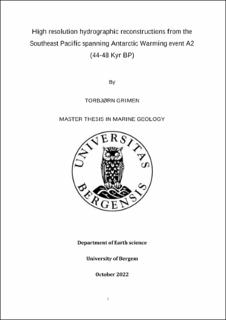| dc.description.abstract | Knowledge about and reconstructions of past climate change is important to distinguish between natural climate variability on various time scales and the more recent man-made climate changes. In this thesis, sub-millennial resolved proxy records of upper ocean variability (foraminiferal assemblages and lithic counts) as well as intermediate ocean variability (benthic oxygen isotopes) are produced from Ocean Drilling Program Site 1233 (41°0.005’S, 74°26.992’W, 838 m.b.s.l) from the Southeast Pacific from 44 to 48 Kyr BP. This interval spans Antarctic Warming event 2, which is one of the most prominent millennial scale warming events observed in Antarctic ice cores. The new records offer the opportunity to simultaneously monitor both AAIW and southeast Pacific surface water properties and unravel how they are influenced by the major atmosphere- and ocean-systems intersecting the study area, as well as unraveling past variations in the Patagonian Ice Sheet. Using planktonic foraminiferal assemblage counts and d 18O to portray climate over A2, we demonstrate that extratropical near surface ocean properties are extremely variable on millennialdecadal timescales. Furthermore, using ice-rafted debris (IRD) counts, and planktonic foraminifer assemblages to infer iceberg supply and melt water input, this study find strong indications for a coupling of the SE Pacific temperature and Patagonian Ice Sheet (PIS) fluctuations during A2 on submillennial time scales. Benthic foraminifera d 18O and d 13C are used to monitor the properties of AAIW close to its source in the Southeast Pacific, and the new benthic isotopic results spanning A2 show that variations in intermediate ocean properties and climate (foraminiferal census counts and planktic isotopes) of the Southeast Pacific closely align with the record of air temperatures from the EPICA Dronning Maud Land ice core on millennial and centennial scales. The abrupt and concurrent shifts in extratropical surface and intermediate ocean properties over A2 are most likely driven by latitudinal shift of frontal systems in the Southern Hemisphere, shifting equatorward during cold phases and poleward during warm intervals. The extension of the Antarctic climate signal into the intermediate ocean demonstrates that AAIW is extremely sensitive and responds rapidly to climate variability in its source region in a broad spectrum of timescales. The broad coherence of the observed Antarctic signal supports the concept of hemispheric thermal asynchrony on millennial timescales. The new results show that changes in ocean temperatures in the Southeast Pacific can have a significant impact on tropical waters and thus tropical climate change. If such natural variations arise today, they can alternately reduce or amplify man-made climate changes. The results can be used in models that simulate the climate change of both the past, the present and the future. | |
